Digital Poster
Deep/Machine Learning-Based Image Acquisition & Reconstruction II
Joint Annual Meeting ISMRM-ESMRMB & ISMRT 31st Annual Meeting • 07-12 May 2022 • London, UK

| Computer # | ||||
|---|---|---|---|---|
1156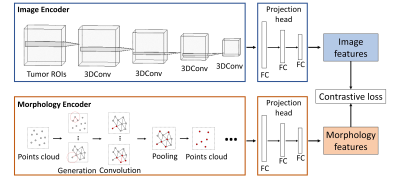 |
61 | Predicting isocitrate dehydrogenase mutation status using contrastive learning and graph neural networks
Yiran Wei1, Chao Li1, and Stephen John Price1
1Department of Clinical Neurosciences, University of Cambridge, Cambridge, United Kingdom
The isocitrate dehydrogenase (IDH) gene mutation status is a prognostic biomarker for gliomas. As an alternative approach to the invasive gold standard of IDH mutation detection, radiogenomics approaches using features of MRI showed promising results in the same task. Here, we proposed an approach to predict the IDH status based on the image and morphology features extracted using contrastive learning. We then constructed a large patient graph based on the extracted features, which could predict the IDH mutation using graph neural networks. The results showed the proposed method outperforms the classifiers which leverage either image or morphology features only.
|
||
1157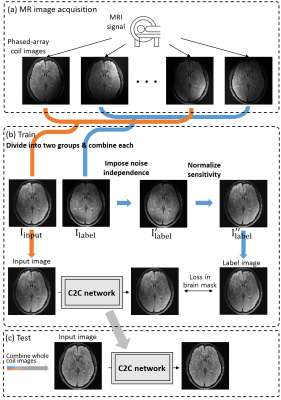 |
62 | Coil to Coil: Self-supervised denoising using phased-array coil images Video Not Available
Juhyung Park1, Dongwon Park2, Hyeong-Geol Shin1, Eun-Jung Choi1, Dongmyung Shin1, Se Yong Chun1, and Jongho Lee1
1Department of Electrical and Computer Engineering, Seoul National University, Seoul, Korea, Republic of, 2Ulsan National Institute of Science and Technology, Ulsan, Korea, Republic of
A self-supervised learning framework, Coil to Coil (C2C), is proposed. This method generates two noise-corrupted images from single phased-array coil data to train a denoising network and, therefore, requires no clean image nor acquisition of a pair of noisy images. The two images are processed to have the same signals and independent noises, satisfying conditions for the noise to noise algorithm, which requires paired noise-corrupted images. C2C shows the best performance among popular self-supervised denoising methods in both real and synthetic noised images, revealing little or no structure in the noise map.
|
||
1158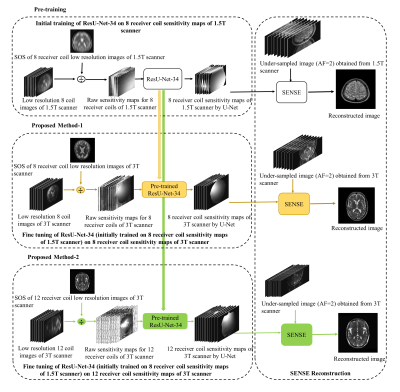 |
63 | Deep Learning-Based Receiver Coil Sensitivity Map Estimation for SENSE Reconstruction using Transfer Learning Video Permission Withheld
Madiha Arshad1, Mahmood Qureshi1, Omair Inam1, and Hammad Omer1
1Medical Image Processing Research Group (MIPRG), Dept. of Elect. & Comp. Engineering, COMSATS University, Islamabad, Pakistan
Many Parallel MRI algorithms (e.g. Sensitivity Encoding (SENSE)) require knowledge of the receiver coil sensitivity maps. Magnetic field strength is an important factor in defining the sensitivity maps of the receiver coils in MRI. This paper presents a method to estimate the receiver coil sensitivity maps of a higher magnetic field strength scanner utilizing a deep learning network (denoted as ResU-Net-34), initially trained on the receiver coil sensitivity maps of a lower field strength scanner using transfer learning. SENSE reconstruction results show a successful domain transfer between the receiver coil sensitivities of different magnetic field strengths with the proposed method.
|
||
1159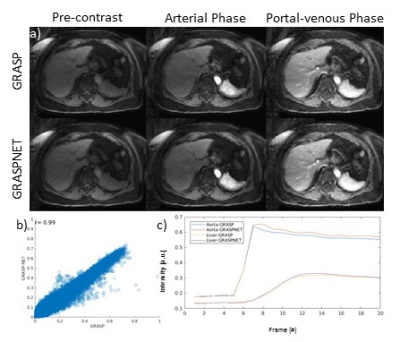 |
64 | GRASPNET: Spatiotemporal deep learning reconstruction of golden-angle radial data for free-breathing dynamic contrast-enhanced MRI
Ramin Jafari1, Richard Kinh Gian Do1, Maggie Fung2, Ersin Bayram2, and Ricardo Otazo1
1Memorial Sloan Kettering Cancer Center, New York, NY, United States, 2GE Healthcare, New York, NY, United States
GRASP is a valuable tool to perform free-breathing dynamic contrast-enhanced (DCE) MRI with high spatial and temporal resolution. However, the 4D reconstruction algorithm is iterative and relatively long for clinical studies. In this work, we present a spatiotemporal deep learning approach to significantly reduce the reconstruction time without affecting image quality.
|
||
1160 |
65 | Denoising Diffusion MRI with Self-supervised Learning on Coresets via Matrix Sketching Video Not Available
Shreyas Fadnavis1, Agniva Chowdhury2, Petros Drineas2, and Eleftherios Garyfallidis1
1Indiana University Bloomington, Bloomington, IN, United States, 2Purdue University, West Lafayette, IN, United States
Diffusion MRI typically has a low SNR on account of the noise from a variety of sources corrupting the data. The state-of-the-art denoiser Patch2Self proposed a self-supervised learning technique that uses patches from all the voxels to learn the denoising function which in practice can be resource-intensive. We, therefore, propose Patch2Self2 which performs self-supervised denoising using coresets constructed via matrix sketching, resulting in significant speedups and reduced memory usage. Our results showed that sampling-based sketching via leverage scores gave the best performance. Remarkably, leverage scores can be directly used as a statistic for interpreting influential regions hampering the denoising performance.
|
||
1161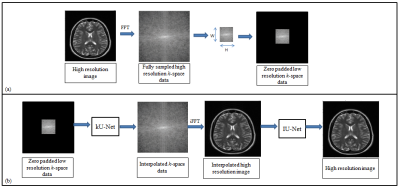 |
66 | Super Resolution of MR Images with Deep Learning Based k-space Interpolation Video Permission Withheld
Madiha Arshad1, Mahmood Qureshi1, Omair Inam1, and Hammad Omer1
1Medical Image Processing Research Group (MIPRG), Dept. of Elect. & Comp. Engineering, COMSATS University, Islamabad, Pakistan
Super resolution of MR images can be used to speed up MRI scan time. However, super resolution is a highly ill-posed problem as the low-resolution images lack high frequency spatial information. In this paper, we propose a hybrid dual domain cascaded U-Net to restore the high-resolution images. Firstly, the U-Net operating in k-space domain is used to interpolate the missing k-space data points and then the U-Net operating in image domain provides a refined high-resolution solution image. Experimental results show a successful reconstruction of high resolution images by using only central 6.25% and 25% k-space data.
|
||
1162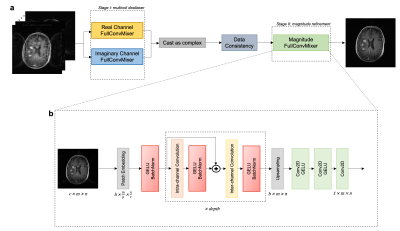 |
67 | Brain MRI acceleration with deep modular networks (BRACELET)
Anthony Mekhanik1, Robert Young2, and Ricardo Otazo1,2
1Dept. of Medical Physics, Memorial Sloan Kettering Cancer Center, New York, NY, United States, 2Dept. of Radiology, Memorial Sloan Kettering Cancer Center, New York, NY, United States
Brain cancer screening utilizing MRI suffers from a bottleneck by requiring 3D acquisitions before and after contrast injection. We designed a novel two-stage deep learning reconstruction pipeline to accelerate 3D brain MRI over conventional 2-fold parallel imaging accelerations used in clinical practice. Using modular deep neural networks, we removed the dependence on one all-encompassing network. We successfully dealiased brain images at higher accelerations and with structural fidelity in lesions superior to conventional clinical imaging. Our method was validated on pathologies unseen during training using qualitative evaluation from an expert neuroradiologist and achieved comparable scores to conventional 2-fold clinical accelerations.
|
||
1163 |
68 | Applying advanced denoisers to enhance highly undersampled MRI reconstruction under plug-and-play ADMM framework
Kang Yan1, Zhixing Wang1, Quan Dou1, Sheng Chen1, and Craig H Meyer1,2
1Biomedical Engineering, University of Virginia, Charlottesville, VA, United States, 2Radiology & Medical Imaging, University of Virginia, Charlottesville, VA, United States
Accelerating MRI acquisition is always in high demand, since long scan time can increase the potential risk of image degradation caused by patient motion. Generally, MRI reconstruction at higher undersampling rates requires regularization terms, such as wavelet transformation and total variation transformation. This work investigates employing the plug-and-play (PnP) ADMM framework to reconstruct highly undersampled MRI k-space data with three different denoiser algorithms: block matching and 3D filtering (BM3D), weighted nuclear norm minimization (WNNM) and residual learning of deep CNN (DnCNN). The results show that these three PnP-based methods outperform current regularization methods.
|
||
1164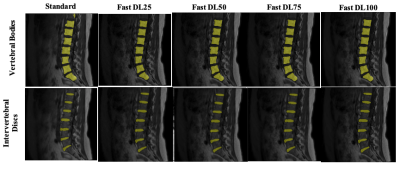 |
69 | DL2: Robustness of Deep Learning Processing on Deep Learning reconstructed Lumbar Spine MRI
Madeline Hess1, Emma Bahroos1, Misung Han1, Kenneth Gao1, Valentina Pedoia1, and Sharmila Majumdar1
1University of California, San Francisco, San Francisco, CA, United States
We demonstrate that fast acquisition images reconstructed robust to segmentation with convolutional neural networks, which are known to generate chaotic errors in response to minimal image perturbations. This finding indicates that low-NEX images with DL-based noise reduction are not only robust to human readers, but machine readers as well.
|
||
1165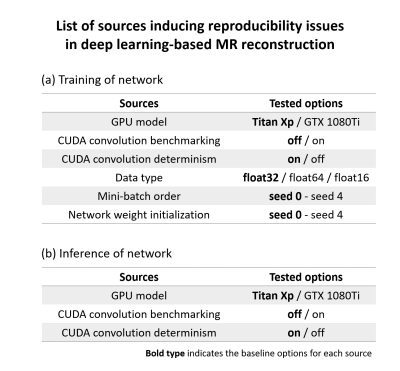 |
70 | Intrinsic reproducibility issues in deep learning-based MR reconstruction
Chungseok Oh1, Woojin Jung2, and Jongho Lee1
1Department of Electrical and Computer Engineering, Seoul National University, Seoul, Korea, Republic of, 2AIRS Medical Inc., Seoul, Korea, Republic of
Deep learning requires a large number of parameter settings, which can be prone to reproducibility issues, undermining the reliability and validity of the outcomes. In this study, we list the common sources that may induce the reproducibility issues in deep learning-based MR reconstruction. The effect size of each source on the network performance was investigated. From the results of this study, we recommend to share a trained network.
|
||
1166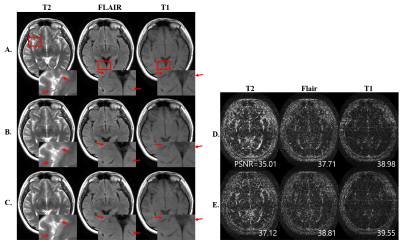 |
71 | Sampling Pattern Optimization for Joint Acceleration of Multi-contrast MRI using Deep Learning
Sunghun Seo1, Huan Minh Luu1, Seung Hong Choi2, and Sung-Hong Park1
1Bio and Brain Engineering, Korea Advanced Institute of Science and Technology, Daejeon, Korea, Republic of, 2Radiology, Seoul National University Hospital, Seoul National University College of Medicine, Seoul, Korea, Republic of
Usage of multiple-acquisition MRI is one field of study that proved its effectiveness and practicality since routine MR scan protocol typically acquires multiple information for the same anatomical structures. In this study, we propose simultaneous optimization of sampling pattern and reconstruction for joint acceleration of multi-contrast MRI. The simultaneous optimization of sampling pattern and reconstruction provided superior performance over single contrast imaging and over single sampling pattern for multi-contrast MRI. The proposed technique can be adopted in routine clinical scan without forcing extra scans during acquisition.
|
||
The International Society for Magnetic Resonance in Medicine is accredited by the Accreditation Council for Continuing Medical Education to provide continuing medical education for physicians.